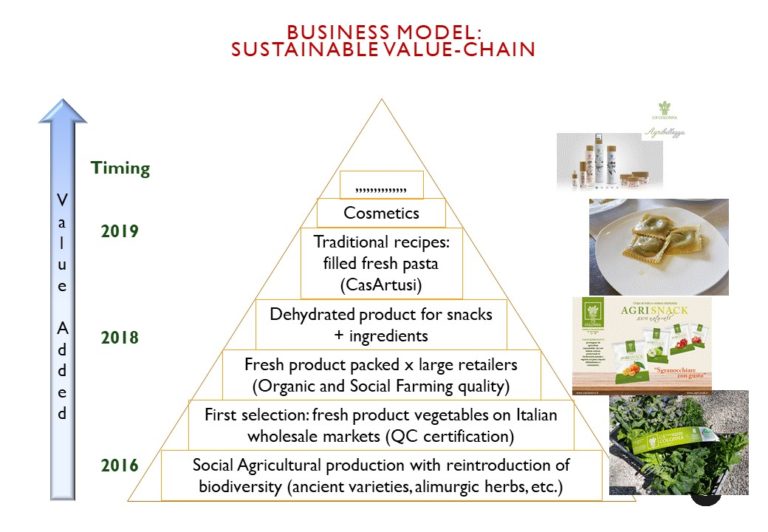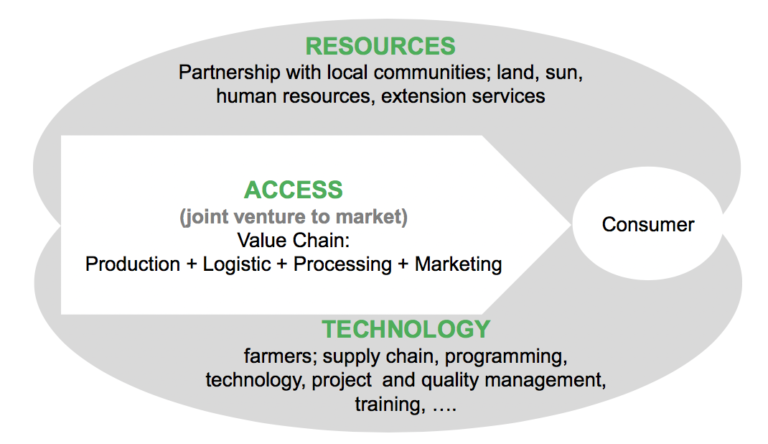Sustainability of the Agri-Food Value-Chain
To create sustainable value in agri-food value-chains we need to introduce new models of governance. These models should aim at increasing capital by granting rights on shares based on the quantity of resources delivered. The current dominant supply chain is based on a linear model of short-term partnerships independent from the influence and interests of other members of the chain (suppliers, processors, retailers, and consumers). Price is the only parameter of evaluation. This model’s results are highly inefficient and unable to respond to changes in supply and demand dynamics. They are also wasteful and cause environmental and social degradation. A system of creating value requires closer cooperation and interaction between all stakeholders. Thus, the development of an agri-food value-chain depends on natural resources, human resources, and their interactions representing the sustainability of the system.
Value-chain innovations, focused more on process than product development, develop sustainable business models by addressing context-specific issues that meet both economic and social objectives. Firms increasingly view responsible innovation as a corporate and strategic necessity for long-term sustainability.

However, to produce corporate value and sustainable development, the supply chain should integrate agro-biodiversity. That is, the product must have a kind of passport that includes the profile of its agri-food chain and traceability. Producers’ organizations should build an interaction process to manage the value-chain with stakeholders; with governments to exploit market opportunities; with consumers to focus local market segments; and with NGOs to anticipate local market debates and social issues.
Consequently, we need new financial tools to mainstream biodiversity in value-chains. The new challenge is to identify the financial sustainability required to reward farmers while making the investments necessary to access the market (e.g., marketing, logistics, packaging). In this perspective, the relationship between financial institutions and enterprises is a key feature for the sustainability of agribusiness companies. Indeed, the relationship between banks and enterprises, as regards access to credit, is based on objective criteria. This criteria measures, along with traditional profitability and financial performance, the company’s self-financing potential and consequently its repayment capacity. Agri-environment and biodiversity are assets that should be taken into consideration for a financial-economic evaluation: methodology and new financial measurements should be investigated.
Social Farming
Social agriculture is multifunctional, combining the traditional function of food production with the ability to generate benefits for vulnerable people. The process gives rise to innovative services that can effectively respond to the crisis of traditional social assistance systems, and the growing demand for personalization and qualification of social services.
As such, social farming should aim to achieve the following:
- Social and work inclusion of workers with disabilities and disadvantages, as qualified by the EU Reg. n. 651/2014, in rehabilitation and social support projects.
- Performance and social and service activities for local communities, using agricultural resources to promote, accompany, and carry out actions to develop the capacity for social and work inclusion, recreation, and services for daily life.
- Services that support medical, psychological, and rehabilitative therapies, aimed at improving the health conditions and the social, emotional and cognitive functions of the subjects involved, also through the activity with animals and the cultivation of plants.
- Projects aimed at environmental and food education, the protection of biodiversity, as well as the dissemination of knowledge of the territory through the organization of social and educational farms of children and of people in social, physical, and mental distress.
From Farming to Agro-Food Parks to Organizing a Value-Chain
Agro-industrial parks or food technopoles, also called agropole/agropolis, are shared facilities and services built explicitly for the processing of agricultural products. An agro-park is a structured community dedicated to the development of agri-food innovation, bringing together the necessary elements for making innovation happen: agro-industries, research and training institutions, and related input and service providers.
An agro-park has to fit in a network containing three strategic functions:
- Rural Transformation Centre: combining collection and storage of farmers’ products with rural development services or perhaps with the utilization of other storage options, such as those storage facilities in Melbourne.
- Agro Production and Processing: combining production, processing, collection, R&D, trade, and social functions. An agro-park delivers its products throughout the year as independently as possible from season and land.
- Consolidation Centre: serves a metropolitan market in a consumer responsive way throughout the year. Seasonal products not available from local producers are supplied from storage or by trade.
The logistical model of an agro-park is based on the concept of connecting urban (consumption) and agricultural (production) areas. The growth of the urban middle class with increasing purchasing power revolutionises food consumption in quality and quantity. The reverse of this process is the marginalisation of rural areas through depopulation, aging, and brain drain. Agro-parks are spatial clusters of several value-chains in an industrial set up, situated close to the metropolis. They contain a variety of independent production, processing, agro-logistic and support functions. Briefly, the logistical concept of an agro-park has two keywords: logistic and cluster. Companies are spatially clustered to create cost economies and efficiency improvements in production and logistics for the sake of economic and environmental advantages. Most companies actively produce, package, and transport agricultural produce. This approach is quite easily exported, but not always well-connected to the local social and natural structure of the territory.
The model of the Italian agri-food districts is based on a territorial approach of the local economy. The traditional and typical agro-food productions are often strictly connected to the presence of the local systems of production. From an economic point of view, local growth models are identified by their production and transaction costs. The advantages of local production systems should also be expanded to include the spatial contiguity and the social and cultural characteristics of a region. Rationalizing resource use means reducing both production and market costs. The growth of systems operating on a regional basis is therefore conditioned by the economies of the surrounding environment which cannot be moved elsewhere. The vision of business development services (BDS) is of a well-functioning market with a diverse array of high-quality services that meet the needs of a large proportion of small and medium enterprises.
The differences in the economies of rural areas will be based on the growth of small and medium/sized companies, more than in the past. Therefore, rural growth should be based on local systems. The growth of a region depends on spatial planning that supports the connection between rural and urban space. Local production is established based on the ability, acquired over the years, to build up specific resources (human, technological) and to manage production processes, rather than geographic advantages.
The interaction between these resources shows whether the agro-parks will remain sustainable over the years. Therefore, comparative advantages determine the growth and location of agro-parks. The value of a location is based on the value of its exchanges and its nontransferable environmental characteristics. Any business is hence located within relations linking human action with the environmental properties of a place.
The Italian Experience of Social Farming: Cà Colonna
Cà Colonna is an innovative agricultural start-up with a social vocation and the aim of organizing and innovating an integrated and sustainable agri-food supply chain for both the environment and the social role.
Cà Colonna has organized an innovation ecosystem through partnerships with the EU Business @ Biodiversity Platform (European Commission); Global Forum of Agricultural Reserch (FAO); Charter of Cancun “Business and Biodiversity Pledge”; National Forum on Social Agriculture; Agri-food Research Dissemination Center of the Food Technology Center of the University of Bologna. The Casa Artusi Foundation trademark licensed the start-up for the development of Artusi’s recipes in the agricultural supply chain. Furthermore, it obtained the QC Quality Controlled certifications (Emilia-Romagna Region), INPS certification of Agricultural Quality and organic certification, and has adopted the first disciplinary of Social Agriculture in Italy.
In Cà Colonna’s first three years of activity, it has already invested in fine-tuning agricultural production in an innovative way. This includes the recovery and reintroduction of biodiversity such as alimurgical herbs and ancient grains, land settlement with the introduction of precision agricultural mechanization and new techniques for the irrigation system.
The company has made food products from agricultural raw materials such as the ancient recipes of Artusi with the Casa Artusi brand for gourmet catering in the world. In a single dish, “culture” and “crops” are connected. Finally, Cà Colonna developed vegetable products, such as agri-snacks and agri-cosmetics, with the aim of enhancing every part of the plant in order to reduce agronomic waste to food.
The whole production process is carried out in the social agricultural supply chain with collaboration of social cooperatives of the Romagna area. The first disciplinary of agricultural-social production was drawn up. The challenge is now to expand this project to a national level.
The African Experience of Social Farming: Texere
The mission of Texere is to organize an integrated agri-food supply chain to guarantee:
- Quality control with traceability of agri-food products from the field.
- Stabilize the costs.
To do this, the supply chain has to be completely integrated in order to internalize the cost and protect from the volatility of international markets, which can be done through direct agreements with local communities. Crop rotation is the base to preserve the sustainability of territory. The following four uses of crops allow a controlled market risk: food, feed (proteins), fiber, and non-food with contract base and stable prices in the long run. Furthermore, partners of Texere include producers and markets as well (closed system and certification of “ethic agriculture” by the Social Accountability Watch).
Texere uses a bottom-up approach. Locals participate in decision-making about strategy and the selection of priorities in their local area. The locals include the population, economic and social interest groups, and representative public and private institutions. Texere considers local people the best experts on the development of their territory. It’s a participatory democracy tool supplementing the electoral parliamentary democracy. As Robert Lukesch and Bernhard Schuh put it in their paper, “The valuation of local skills and knowledge does not only boost the self-awareness of local people and changes their perception of the area in which they live, it also fosters innovative solutions and competitive advantage of value-adding activities, ultimately of the territory itself.”
An area-based approach takes a small, homogenous, socially cohesive territory, often characterised by common traditions, a local identity and a sense of belonging or common needs and expectations as the target area for policy implementation. Forming local partnership is the most appropriate approach, combining the participation of local citizens with decentralised top-down support and funding from regional and national programs.

West Growth Policy Development Project PDPC (DON N. H860-ZR)
- Achievement and management of three agroindustrial platforms to be implanted at Lukula in Central Congo Province (Democratic Republic of Congo).
A group of Italian companies including the Italian Monitoring Society – SIM of Rome, SOVIMP of Padua, and CRONO Servizi of Forlì, was awarded the Développement de Pôles de Croissance Ouest (PDPC) project in the territory of Lukula, in the Bas Fleuve District, Kongo Central province of the Democratic Republic of the Congo.
The World Bank funded the project with a grant of 12 million dollars. The goal is to improve agro-industrial production in the Democratic Republic of the Congo. The country, while portraying great agricultural potential, is decidedly lacking an integrated supply chain between agricultural and urban areas. On one hand, there is traditional agricultural territory, and on the other a growing urban system, increasingly dependent on food imports. This project will involve about 1,000 family farms and about 4.000 Ha in partnership with Texere.
The Italian group is in charge of restructuring the industrial plants, and supplying the machinery to produce palm oil, cassava flour, and peeled rice for the domestic market. The construction phase will last for about one year. Afterwards, the group will undertake management of the agro-industrial platform for another three years. During this period, the group will be in charge of ensuring the operation of the plant, the maintenance of the platform, organizing the agricultural producers, and the logistics of supplying a sales network with the processed products.
The innovative aspect of the project is the fact that this Italian partnership is not only responsible for the design of the plant and its structural implementation, but also management and organization of the entire food chain. To strengthen the relationship with the social territory, the companies involved the Diocese of Boma as an operating partner of Texere Congo. To this end, the group will act as a contracting entity delegated on behalf of the Cellule d’Exécution des Financements des États Fragiles (CFEF). The CFEF is an operational structure of the Ministry of Finance of the DRC.












